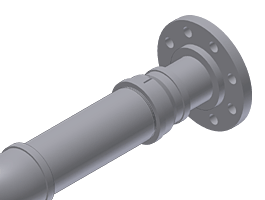To Modify Fittings in Rigid Routes
Change the orientation or diameter, replace, and delete existing fittings.

When a rigid route is populated, conduit parts and fittings are generated from the Content Center based on the style criteria. Fittings can also be manually placed into a tube and pipe assembly from the Content Center using AutoDrop or from your project workspace.
Change the orientation and connection point of a placed fitting
Activate the pipe run.
Select one or more placed fittings, right-click and select Edit Fitting Orientation.
Note: The fittings need not be adjacent when selecting multiple fittings.Use the 3D Orthogonal Route tool displayed to edit the orientation and the connection point of the fitting.
Use the direction axes to rotate the fitting to a new orientation. For exact rotation, right-click the axis and select Enter Angle to enter a precise value.
To change the connection point, right-click in the graphics window and use Select Orientation to set the new connection point, or press the spacebar.
Note: If you are reorienting a direction fitting or multiple fittings, the axes of the 3D Orthogonal Route tool are not available so you can only change the connection point.
Right-click in the graphics window and select Done.
Replace existing fittings
You can replace one occurrence of a selected fitting instance with a new fitting instance from the Content Center or all occurrences at once. The new fitting is placed at the previously defined route point. If the fitting is one of several adjacent fittings, the new fitting is placed at the previously defined location and connections are maintained even though there may be no defined route point for the selected fitting.
Activate the run containing the fitting to replace.
 In the Model browser or graphics window, right-click the fitting and select Replace from Content Center.
In the Model browser or graphics window, right-click the fitting and select Replace from Content Center.The Replace Component dialog box displays the category view in the Content Center.
On the Category View list, navigate to the replacement fitting and double-click the part family. To quickly locate the desired fitting, use the available commands such as Search, Filter, and so on.
Select the needed fitting parameters, typically ND (Nominal Diameter).
To replace all occurrences of the highlighted fitting type, select the Replace All check mark.
Determine whether you want to place the fitting as a custom part or a standard part.
Review other parameters of the selected library part on the Table View and Family Info tabs.
To complete selecting the part, click OK.
The specified fitting(s) are replaced automatically.
 Route panel
Route panel  Place Fitting command and move the fitting over the target fitting to accomplish a single occurrence replacement.
Place Fitting command and move the fitting over the target fitting to accomplish a single occurrence replacement.Restore a placed fitting to default fitting (elbow or coupling)
Activate the pipe run.
Right-click a placed fitting and select Restore Fitting.
The fitting is restored to a coupling or elbow where appropriate.
To delete a non-base or the base fitting from a group of fittings
If the fitting is in the middle of a group of adjacent fittings, it is removed leaving a gap between the two fitting groups. If the fitting is the base fitting for a group of multiple adjacent fittings you can delete the entire group of fittings or only the selected base fitting. If deleting the base fitting only, you must also specify the new base fitting and how to position it.
In cases where the route point is owned by two fittings, such as with flanged fittings, the inserted fitting becomes the new base fitting that owns the route point. The other fittings adjust accordingly.
In the Model browser, double-click the pipe run.
To delete a non-base fitting: Right-click the fitting to remove, and then select Delete.
To delete the base fitting from a group of fittings: Right-click the fitting to remove, and then select Delete. In the Delete Fitting dialog box indicate whether to delete the entire group or the selected fitting only.
If deleting the entire group, click OK to complete the deletion. If deleting the selected base fitting, indicate what to use as the new base fitting:
The route point for the base fitting being removed, or
One of two adjacent fittings
Note: If the deleted fitting is between a fitting and a pipe segment, the fitting is automatically the new base fitting.
If an adjacent fitting was selected, indicate where to position this new base fitting:
- Click move route point to move the route point to the location of the new base fitting.
- Click move base fitting to move the base fitting to the route point of the deleted base fitting.
Click OK.
Change diameter for multiple fittings
When changing the diameter for one or multiple fittings, the system finds the diameters that are common to all selected fittings and displays them in a list. You can select a new diameter from this list.
Activate the pipe run.
In the graphics window or the Model browser, select the fittings to change. Press Ctrl or Shift to select multiple fittings.
Right-click, and then select Change Fitting Diameter.
Note: If there are no diameters in common, reduce the number of fittings in the selection, and repeat Steps 1 and 2 until one is found.In the Select Diameter dialog box, select a common diameter to changes diameters to a size that is common to all selected fittings.
Click OK.
